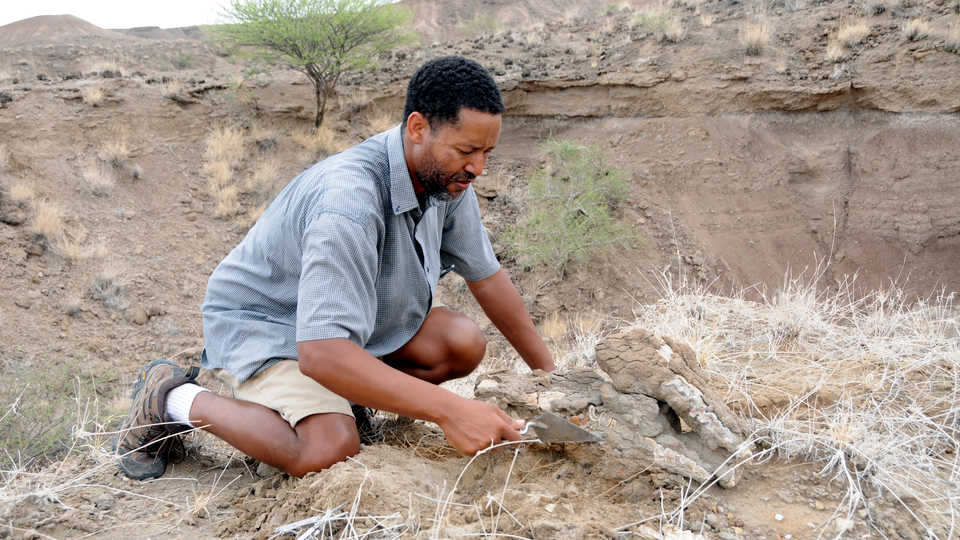3D shape analysis of primate shoulder blades answers longstanding questions about the “Homo-Pan” last common ancestor
SAN FRANCISCO (September 7, 2015) – Mere weeks after President Obama’s landmark introduction to “Lucy”—the 3.2 million-year-old Australopithecus afarensis discovered in Ethiopia in 1974—scientists are announcing findings about our earliest human ancestors using innovative techniques. A team of paleoanthropologists—including Zeray Alemseged, the senior curator of anthropology from the California Academy of Sciences who introduced Lucy to Obama—have determined that the last common ancestor of humans and chimpanzees was similar to a modern African ape. These findings answer a longstanding evolutionary mystery through a 3D exploration of a single important body part: the shoulder blade (scapula). The study is published this week in the journal Proceedings of the National Academy of Sciences.
“When attempting to predict the common ancestor between chimpanzees and humans, fossils tell the most complete stories,” says Alemseged, who co-authored the study with Nathan Young along with colleagues from Harvard University and the American Museum of Natural History. “When fossils are absent, however, we have to employ sophisticated techniques to compensate for blank spaces.”
“There have been several hypotheses about the common ancestor’s identity, but most rely on shaky grounds or a single species,” says Alemseged. “Our study is the first to take a holistic view of existing evolutionary evidence in all of its complexity. The strength of our approach lies in this big-picture view.”
The research team focused on the shoulder blade because of its critical importance to key behaviors in human evolution including locomotion, tool use, and throwing. The evidence shows that as our ancestors became less adapted to living in trees and began using tools and throwing, the shape of their shoulder blade changed as well. The most likely model for the evolution of the human shoulder shape begins with an ancestor much like an African ape.
Young, assistant professor at the UC San Francisco School of Medicine and lead author on the study, says fossil evidence suggests this shift to living on the ground happened incredibly slowly—emphasizing the vast time needed for the genetic changes that drive evolution.
“These results support some of my team’s previous research regarding the presence of tool use and climbing in earlier humans,” says Alemseged. “We now know more about the developmental and evolutionary forces that control the shape of the shoulder.”
One shoulder specimen targeted for 3D shape analysis carried particular meaning for Alemseged. In 2000, he discovered “Selam”—the 3.3 million-year-old skeleton of a female A. aferensis child—in Ethiopia. Selam’s scapula joined several other fossils in this exploration of the Homo-Pan split, proving that her remains continue to inform our understanding of the evolutionary changes that gave rise to modern humanity.
“Time and time again, the fossil record reminds us that we are part of an ever-changing world,” says Alemseged, who recently discussed the power of human connection with President Obama during his visit with Lucy in Ethiopia. “This study of the changing shoulder shape is the first of its kind, and applying these techniques to the rest of the skeleton is the next frontier.”
Visitors to the Academy can trace human history milestones in African Hall’s Human Odyssey—the Academy exhibit featuring casts of Lucy and Selam alongside portrayals of scientific efforts to discover the roots of humanity in Africa and beyond.
This work was supported by funding from the National Science Foundation (Grant BCS-1518596); Margaret and William Hearst; the National Institutes of Health (Grants R01DE019638 and R01DE021708); and the ongoing support of the UCSF Orthopaedic Trauma Institute; T. Miclau; R. Marcucio; and the Laboratory for Skeletal Regeneration.
The Institute for Biodiversity Science and Sustainability at the California Academy of Sciences is at the forefront of efforts to understand two of the most important topics of our time: the nature and sustainability of life on Earth. Based in San Francisco, the Institute is home to more than 100 world-class scientists, state-of-the-art facilities, and nearly 46 million scientific specimens from around the world. The Institute also leverages the expertise and efforts of more than 100 international Associates and 400 distinguished Fellows. Through expeditions around the globe, investigations in the lab, and analysis of vast biological datasets, the Institute’s scientists work to understand the evolution and interconnectedness of organisms and ecosystems, the threats they face around the world, and the most effective strategies for sustaining them into the future. Through innovative partnerships and public engagement initiatives, they also guide critical sustainability and conservation decisions worldwide, inspire and mentor the next generation of scientists, and foster responsible stewardship of our planet.
Press Contacts
If you are a journalist and would like to receive Academy press releases please contact press@calacademy.org.
Digital Assets
Hi-res and low-res image downloads are available for editorial use. Contact us at press@calacademy.org to request access.


